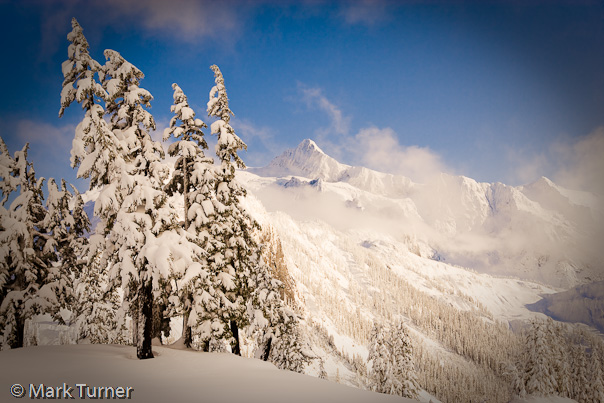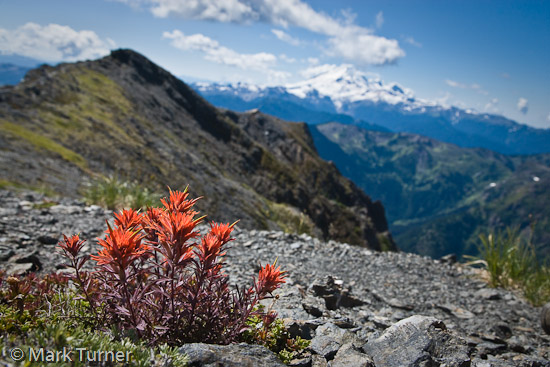
What a day! And what a difference a month makes. Compare this photo with the one from October 12.
I was sitting happily captioning photos this morning when I looked out the window and saw that the sky was a stunningly clear blue. I stepped out to the side yard where I can see Mt. Baker and it was clear all the way to the top of the mountain. Much too nice to stay inside so I gathered my gear, made lunch, changed into winter hiking clothes, and headed up Mt. Baker Highway to the end of the road at the Mt. Baker Ski Area. One little glitch along the way. I forgot my wallet at home, realized it when I stopped for gas in Deming, and had to return to Bellingham for it.
 I didn’t get to the ski area parking lot, which was full, until almost 12:30. That was OK since I wanted afternoon light. But it wasn’t OK, because I was racing the clouds that had started to roll in.
I didn’t get to the ski area parking lot, which was full, until almost 12:30. That was OK since I wanted afternoon light. But it wasn’t OK, because I was racing the clouds that had started to roll in.
I strapped on my snowshoes and headed up toward Artist Point, initially following the groomed ski runs until I got to the top of Blueberry. There I passed the “entering wilderness if you have a problem tough luck” sign as I left the ski area and entered the backcountry. I wasn’t particularly concerned about avalanche danger even though we’d just gotten a ton of fresh soft snow. I continued up to Austin Pass where I stopped to make the photo at the top of the post.
From Austin I climbed up a steep boot and ski track that mostly followed the summertime Wild Goose Trail. It’s the short, steep, and fast way up. The snow was soft and deep so I was glad not to be breaking trail. I made the photo on the right soon after topping out from the steep climb. The ski tracks looked to be from yesterday as they’d started to fill in.
 I don’t know just what made these tracks zig zagging across the snow. Could have been a meadow vole or other small rodent that dens under the snow. There were several sets of tracks similar to these in the snow just below Artist Point. I particularly liked this set of tracks because of the way they curved around. What distracted the critter from a straight path?
I don’t know just what made these tracks zig zagging across the snow. Could have been a meadow vole or other small rodent that dens under the snow. There were several sets of tracks similar to these in the snow just below Artist Point. I particularly liked this set of tracks because of the way they curved around. What distracted the critter from a straight path?
By this point there were fewer people around since most folks out today were sking or boarding inbounds at the ski area. Just a few hardy soles made the hike for some fresh tracks below Table Mountain. I was sinking nearly to my knees wearing snowshoes. The Artist Point outhouse was buried in snow deeper than the top of the doors. Within a couple of weeks it’s likely to be completely buried as it is every winter. The official snow report was 72 inches on top of Pan Dome and Artist Point is higher so there was probably more snow up there.
Clouds were by now starting to roll in from the south and west. Mt. Baker was obscured and Shuksan was in and out. I had planned to continue out the ridge to Huntoon Point, wanting to photograph Shuksan from my favorite tarn just below the point. But with the thick clouds and no trail through the deep snow I decided Artist Point was a good destination for today.
 I broke trail the short distance to the overlook toward Swift Creek and Baker Lake. Clouds obscured the lake as well as Mt. Baker, but the snow crusted on the Mountain Hemlocks along the ridge created more accessible drama. I ate my peanut butter sandwich under this tree, admiring the way the wind had blasted the snow into the branches, almost completely hiding the foliage.
I broke trail the short distance to the overlook toward Swift Creek and Baker Lake. Clouds obscured the lake as well as Mt. Baker, but the snow crusted on the Mountain Hemlocks along the ridge created more accessible drama. I ate my peanut butter sandwich under this tree, admiring the way the wind had blasted the snow into the branches, almost completely hiding the foliage.
I’ve been up to this spot many times over the past 19 years and most of the time on winter visits the trees look much like this. The branches are short and stubby, hanging down to shed some of their snow load. I think this effect is caused by the relatively wet snow we receive in combination with the prevailing southwest wind. We call it the pineapple express, but I don’t think this tortured lollypop of a tree looks anything like a pineapple. A popsicle, maybe.
Hopefully this is just the first of many days I’ll be out playing in the snow this winter.
In case you’re wondering, I shot all of these with my Canon 1Ds Mk II, handheld for a change with the 24-105mm IS lens. The two of the tracks are pretty much straight from the camera, but the view of Shuksan and the Hemlock have been manipulated in Lightroom.





 I didn’t get to the ski area parking lot, which was full, until almost 12:30. That was OK since I wanted afternoon light. But it wasn’t OK, because I was racing the clouds that had started to roll in.
I didn’t get to the ski area parking lot, which was full, until almost 12:30. That was OK since I wanted afternoon light. But it wasn’t OK, because I was racing the clouds that had started to roll in. I don’t know just what made these tracks zig zagging across the snow. Could have been a meadow vole or other small rodent that dens under the snow. There were several sets of tracks similar to these in the snow just below Artist Point. I particularly liked this set of tracks because of the way they curved around. What distracted the critter from a straight path?
I don’t know just what made these tracks zig zagging across the snow. Could have been a meadow vole or other small rodent that dens under the snow. There were several sets of tracks similar to these in the snow just below Artist Point. I particularly liked this set of tracks because of the way they curved around. What distracted the critter from a straight path? I broke trail the short distance to the overlook toward Swift Creek and Baker Lake. Clouds obscured the lake as well as Mt. Baker, but the snow crusted on the Mountain Hemlocks along the ridge created more accessible drama. I ate my peanut butter sandwich under this tree, admiring the way the wind had blasted the snow into the branches, almost completely hiding the foliage.
I broke trail the short distance to the overlook toward Swift Creek and Baker Lake. Clouds obscured the lake as well as Mt. Baker, but the snow crusted on the Mountain Hemlocks along the ridge created more accessible drama. I ate my peanut butter sandwich under this tree, admiring the way the wind had blasted the snow into the branches, almost completely hiding the foliage.



 Mid-October is getting toward the end of the good weather in the North Cascades. I took advantage of a nice day today to head up toward Mt. Baker to photograph the mountain and the rugged crevasses and seracs on the lower portion of the Coleman glacier. I made this self-portrait at the high point of my hike, a bit over 5900 feet elevation. The crevasse I’m stradling wasn’t very deep so I felt comfortable going out on the glacier by myself without an ice axe. However, I didn’t go any farther than where I’m standing.
Mid-October is getting toward the end of the good weather in the North Cascades. I took advantage of a nice day today to head up toward Mt. Baker to photograph the mountain and the rugged crevasses and seracs on the lower portion of the Coleman glacier. I made this self-portrait at the high point of my hike, a bit over 5900 feet elevation. The crevasse I’m stradling wasn’t very deep so I felt comfortable going out on the glacier by myself without an ice axe. However, I didn’t go any farther than where I’m standing.